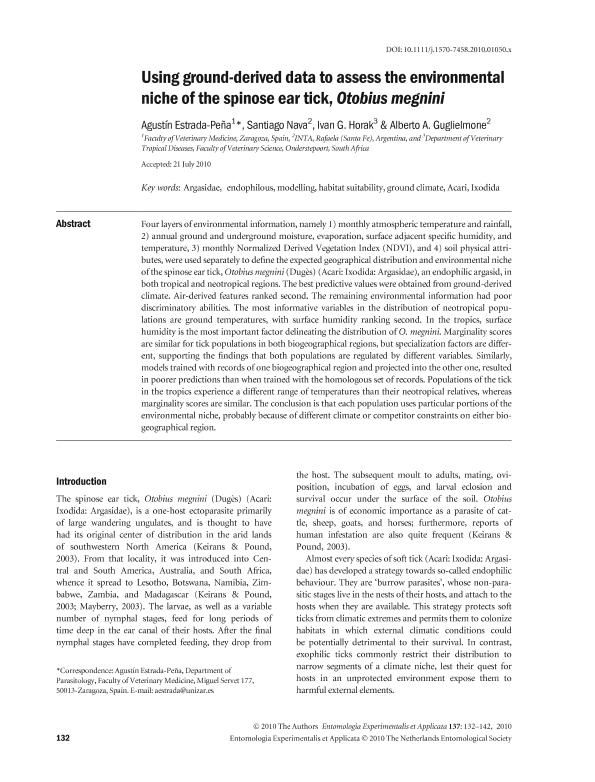Mostrar el registro sencillo del ítem
dc.contributor.author
Estrada Peña, Agustín
dc.contributor.author
Nava, Santiago

dc.contributor.author
Horak, Ivan G.
dc.contributor.author
Guglielmone, Alberto Alejandro

dc.date.available
2018-11-13T14:19:06Z
dc.date.issued
2010-11
dc.identifier.citation
Estrada Peña, Agustín; Nava, Santiago; Horak, Ivan G.; Guglielmone, Alberto Alejandro; Using ground-derived data to assess the environmental niche of the spinose ear tick, Otobius megnini; Wiley Blackwell Publishing, Inc; Entomologia Experimentalis et Applicata; 137; 2; 11-2010; 132-142
dc.identifier.issn
0013-8703
dc.identifier.uri
http://hdl.handle.net/11336/64313
dc.description.abstract
Four layers of environmental information, namely 1) monthly atmospheric temperature and rainfall, 2) annual ground and underground moisture, evaporation, surface adjacent specific humidity, and temperature, 3) monthly Normalized Derived Vegetation Index (NDVI), and 4) soil physical attributes, were used separately to define the expected geographical distribution and environmental niche of the spinose ear tick, Otobius megnini (Dugès) (Acari: Ixodida: Argasidae), an endophilic argasid, in both tropical and neotropical regions. The best predictive values were obtained from ground-derived climate. Air-derived features ranked second. The remaining environmental information had poor discriminatory abilities. The most informative variables in the distribution of neotropical populations are ground temperatures, with surface humidity ranking second. In the tropics, surface humidity is the most important factor delineating the distribution of O. megnini. Marginality scores are similar for tick populations in both biogeographical regions, but specialization factors are different, supporting the findings that both populations are regulated by different variables. Similarly, models trained with records of one biogeographical region and projected into the other one, resulted in poorer predictions than when trained with the homologous set of records. Populations of the tick in the tropics experience a different range of temperatures than their neotropical relatives, whereas marginality scores are similar. The conclusion is that each population uses particular portions of the environmental niche, probably because of different climate or competitor constraints on either biogeographical region.
dc.format
application/pdf
dc.language.iso
eng
dc.publisher
Wiley Blackwell Publishing, Inc

dc.rights
info:eu-repo/semantics/openAccess
dc.rights.uri
https://creativecommons.org/licenses/by-nc-sa/2.5/ar/
dc.subject
Acari
dc.subject
Argasidae
dc.subject
Endophilous
dc.subject
Ground Climate
dc.subject
Habitat Suitability
dc.subject
Ixodida
dc.subject
Modelling
dc.subject.classification
Zoología, Ornitología, Entomología, Etología

dc.subject.classification
Ciencias Biológicas

dc.subject.classification
CIENCIAS NATURALES Y EXACTAS

dc.title
Using ground-derived data to assess the environmental niche of the spinose ear tick, Otobius megnini
dc.type
info:eu-repo/semantics/article
dc.type
info:ar-repo/semantics/artículo
dc.type
info:eu-repo/semantics/publishedVersion
dc.date.updated
2018-11-05T19:08:28Z
dc.journal.volume
137
dc.journal.number
2
dc.journal.pagination
132-142
dc.journal.pais
Reino Unido

dc.journal.ciudad
Londres
dc.description.fil
Fil: Estrada Peña, Agustín. Universidad de Zaragoza; España
dc.description.fil
Fil: Nava, Santiago. Instituto Nacional de Tecnología Agropecuaria. Centro Regional Santa Fe. Estación Experimental Agropecuaria Rafaela; Argentina. Consejo Nacional de Investigaciones Científicas y Técnicas. Centro Científico Tecnológico Conicet - Santa Fe; Argentina
dc.description.fil
Fil: Horak, Ivan G.. Universiteit Van Pretoria; Sudáfrica
dc.description.fil
Fil: Guglielmone, Alberto Alejandro. Instituto Nacional de Tecnología Agropecuaria. Centro Regional Santa Fe. Estación Experimental Agropecuaria Rafaela; Argentina. Consejo Nacional de Investigaciones Científicas y Técnicas. Centro Científico Tecnológico Conicet - Santa Fe; Argentina
dc.journal.title
Entomologia Experimentalis et Applicata

dc.relation.alternativeid
info:eu-repo/semantics/altIdentifier/doi/http://dx.doi.org/10.1111/j.1570-7458.2010.01050.x
dc.relation.alternativeid
info:eu-repo/semantics/altIdentifier/url/https://onlinelibrary.wiley.com/doi/abs/10.1111/j.1570-7458.2010.01050.x
Archivos asociados
